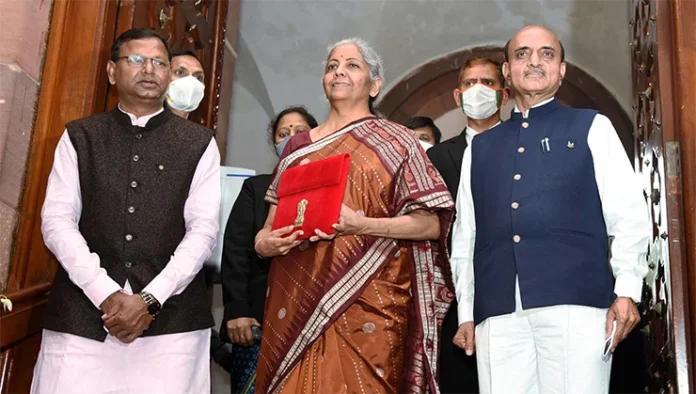Ahead of the presentation of Union budget in Parliament on February 1, India’s defence sector deserves to be in the spotlight due to increased volatility with belligerent neighbours. That apart, the political and military fallout of the ongoing war between Russia and Ukraine has necessitated an urgent need to recalibrate defence preparedness, calling for a deeper evaluation of the threat perception in the near and long term. In view of this, it may not be out of context to expect a significant increase in budgetary allocation as a percentage increase from the previous year’s allocation.
Traditionally, the gross underpinning of the defence allocation has been ritualistic in sharp contrast to developmental allocation. Obtusely, defence analysts have been voicing their concerns that the enduring financial deprivation to the services is presumed to be a direct fallout of the civilian bureaucracy’s inability to grasp the strategic imperative of capability building given the imminent threat perceived.
In fact, budgetary allocation for the defence has always fallen short of the projections by the Ministry of Defence. That notwithstanding, the Government has risen to emergent requirements of the armed forces irrespective of the budget allocation in the past. The 15th Finance Commission has recommended the constitution of a dedicated non-lapsable Modernisation Fund for Defence and Internal Security (MFDIS) to bridge the gap between projected budgetary requirements and allocation for national security for the period 2021–26. The Commission has also recommended that of the total amount of ₹2.4 lakh crore, the MoD would be entitled to ₹1.88 lakh crore or 79% of the MFDIS. This not only reflects the Government’s resolve to meet the aspirations of the defence but has set a precedence in continued increase in budgetary allocation as a percentage of the GDP year on year. Analysis of the past defence budgets reflects that the defence budget has shown an increase varying from 2.1% to 9%.
Another significant imperative for the increase has been the Atmanirbhar Bharat initiative which has spurned domestic defence production. The negative list of 1,238 subsystems and the positive list of 410 big weapon systems only to be procured indigenously, will result in bridging the budgetary gap. In this context, the Defence Acquisition Council has recently cleared proposals worth over ₹84,000 crore. Of the 24 capital acquisition proposals, six are for Indian Army, six for Indian Air Force, 10 for Indian Navy and two for Indian Coast Guard. From an equipment perspective, light tank and FICVs are among the significant proposals for the Army while the Indian Air Force will significantly enhance its lethal capabilities through the induction of a new missile system, long-range guided bombs and advanced surveillance systems. The naval hardware includes new anti-ship missiles, multi-purpose vessels and high endurance autonomous vehicles that will further enhance maritime strength. Thus, Indigenisation of military hardware ranks among the government’s top priorities.
Therefore, given the twin requirements of capability development and indigenous production, this year’s budget will certainly see an upward trend on an incremental basis. On a conservative estimate, we can expect an increase of anything between 7-12% in defence budget allocation. Further, from a military stand point the ongoing Russia-Ukraine conflict has conclusively established that conventional military engagement will continue to reign supreme despite asymmetric capabilities. The engagements will be long drawn. Therefore, adequate funding is essential to build capabilities to fight protracted wars. This remains accentuated due to our volatile borders on two fronts. In addition, the need to develop asymmetric capabilities in space, cyber, artificial intelligence, quantum technologies and blockchain requires significant funding.
From an international standpoint, the Quad wants India to play a significant role in defending marine trade routes passing through the Indian Ocean as well as emerge as a strong maritime opponent to China. Hence, given these diverse international and domestic security compulsions, the Defence Budget expectation could be around Rs 6 lakh crore or even higher. Going by the past trend of India’s defence budget for 2022-23 being ₹5,25,166 crore ($70.6 billion), the allocation for defence expenditure for the ensuing FY could increase by 10-12% over the current financial year’s budget estimates. Ironically, majority of it would go into salaries (31%) and pensions (23%) and only about 24% of defence budget is allocated for weapons, equipment for modernisation.
A brief look at the fiscal status of the government may auger well. The stark reality is that budgeting remains a zero-sum game. The budget outlay for defence and other sectors is circumscribed by the total revenue the government generates via taxes and other miscellaneous means like disinvestment in the public sector, and non-tax revenue which consists of interest receipts on loans given by the Centre, dividends and profits, external grants, and receipts from general, economic, and social services, among others.
Since the expenditure always trumps the income, governments routinely resort to borrowing money to manage budgets. Unfortunately, all these sources of revenue – taxes, non-tax receipts, miscellaneous income, and borrowing – have inherent limitations. Increasing taxes or widening the tax net is, without a doubt, an unpopular gambit. No government can risk the political and social cost of such a step, unless unavoidable. With nine state assembly elections due later this year, followed by parliamentary polls in early 2024, the possibility of any substantial increase in taxes can safely be ruled out in FY 2023-24.
In so far as borrowing is concerned, as the experience of India’s two neighbours – Pakistan and Sri Lanka – demonstrates, unfettered borrowing, measured in terms of debt-to-GDP ratio, can be ruinous, as it entails a high risk of default in loan repayment and discharging other sovereign financial obligations. According to a World Bank study, such a ratio that exceeds 77% over an extended period can have an adverse impact on economic growth. India’s debt-to-GDP ratio has been hovering over 83% since 2020. It currently stands at 83.4% and is estimated by financial analysts to remain at these levels till at least 2027.
In the face of such economic constraints, it is futile to expect the defence expenditure to receive any priority, irrespective of the revenues generated, and to the exclusion of other critical sectors like health, education, agriculture, infrastructure development, internal security, environment, and poverty alleviation, amongst others. However, egged on by a section of influential opinion makers, the government has taken several curious steps like proscribing the import of 410 defence items in a phased manner, allocation of a high percentage of the capital budget for materiel procurement from indigenous sources and locally manufacturing military equipment via a transfer of technology from overseas original equipment manufacturers ((OEMs) under the rubric of ‘Make in India’. Similarly other policy initiatives, such as earmarking 25% of the research and development budget for the private sector, establishing a ‘non-lapsable’ pool of funds to modernise the armed forces, remain a work in progress. None of these vacuous steps can address the fundamental problem of continuing paucity of funds.
Be that as it may, bowing to the ubiquitous political considerations, the finance minister may refer to the ‘successes’ of some of the earlier ‘initiatives’ mentioned above or announce new ones in her budget speech to showcase the government’s commitment to national security by way of Atmanirbharta, or self-reliance in defence, which has become the new norm for reinvigorating India’s defence allocation without any substantial hike in the defence outlay.
–The writer is a former GOC-Indian Army and presently a Strategic Consultant, Principal Advisor. Views expressed are personal and do not necessarily reflect the views of Raksha Anirveda
–The writer is a former GOC of the Indian Army and presently serves as a Strategic Consultant and Principal Advisor. The views expressed are of the writer and do not necessarily reflect the views of Raksha Anirveda














